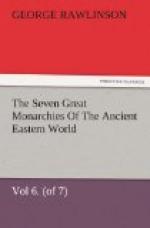But this was not the whole. In addition to these light troops, a Parthian army comprised always a body of heavy cavalry, armed on an entirely different system. The strong horses selected for this service were clad almost wholly in mail. Their head, neck, chest, even their sides and flanks, were protected by scale-armor of brass or iron, sewn, probably, upon leather. Their riders had cuirasses and cuisses of the same materials, and helmets of burnished iron. For an offensive weapon they carried a long and strong spear or pike. They formed a serried line in battle, bearing down with great weight on the enemy whom they charged, and standing firm as an iron wall against the charges that were made upon them. A cavalry answering to this in some respects had been employed by the later Persian monarchs, and was in use also among the Armenians at this period; but the Parthian pike was apparently more formidable than the corresponding weapons of those nations, and the light spear carried at this time by the cavalry of a Roman army was no match for it.
The force entrusted to Surenas comprised troops of both these classes. No estimate is given us of their number, but it was probably considerable. At any rate it was sufficient to induce him to make a movement in advance—to cross the Sinjar range and the river Khabour, and take up his position in the country between that stream and the Belik—instead of merely seeking to cover the capital. The presence of the traitor Abgarus in the camp of Crassus was now of the utmost importance to the Parthian commander. Abgarus, fully trusted, and at the head of a body of light horse, admirably adapted for outpost service, was allowed, upon his own request, to scour the country in front of the advancing Romans, and had thus the means of communicating freely with the Parthian chief. He kept Surenas informed of all the movements and intentions of Crassus, while at the same time he suggested to Crassus such a line of route as suited the views and designs of his adversary. Our chief authority for the details of the expedition tells us that he led the Roman troops through an arid and trackless desert, across plains without tree, or shrub, or even grass, where the soil was composed of a light shifting sand, which the wind raised into a succession of hillocks that resembled the waves of an interminable sea. The soldiers, he says, fainted with the heat and with the drought, while the audacious Osrhoene scoffed




